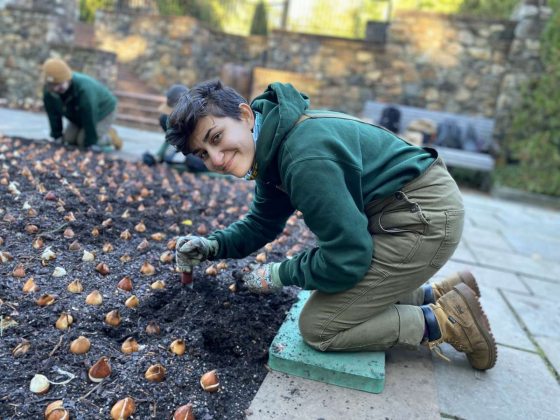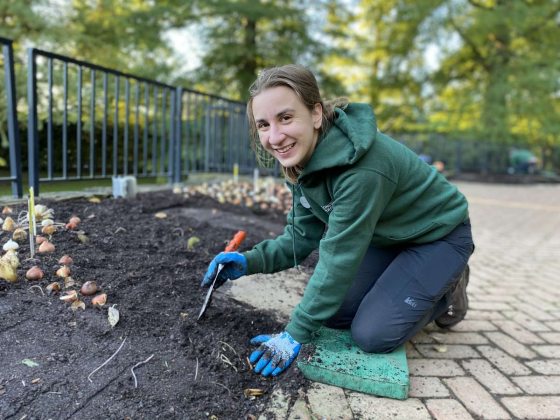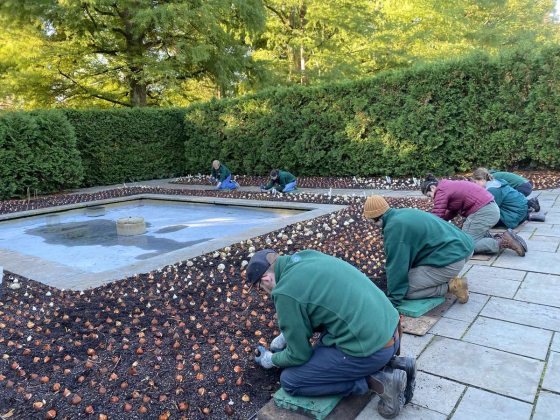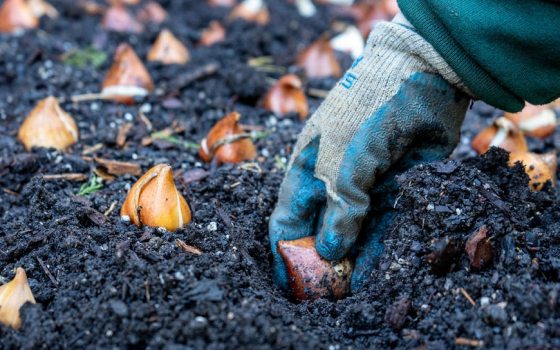Whether you prefer cheery daffodils, fragrant hyacinths, whimsical irises, or vibrant tulips, bulbs—which lead to those flowers—are beloved for their beauty, simplicity, and variety … and for their ability to provide a welcoming landscape of color after a long, bleak winter. We marvel at their diversity of color and form while appreciating how they can burst forth in bloom when the landscape is eager for color. In the meantime, now is the time to plant those bulbs—just as the Longwood intern class did in late October—in preparation for next year’s spring display.

What is a bulb?
There is a lot more to flowering bulbs than meets the eye. Fall-planting bulbs are planted in the fall, grow roots into winter, then sprout and bloom in the spring. This type of bulb includes such favorites as tulips, daffodils, and hyacinths. Spring-planting bulbs, however, cannot survive cold ground temperatures and are planted in the spring and flower throughout the summer. They include dahlias, gladiolus, cannas, and calla-lilies.
Depending on their type, bulbs can bloom in early, mid-, and late spring. By choosing bulbs that flower at different times during the growing season, you can always have something beautiful coming into bloom. For a continuous parade of color, plant some bulbs that will burst forth at each time period in preparation for the bloom season.

Despite their differences in bloom time, within the flowering bulb lies just about everything the plant needs to sprout and flower at the appropriate time. Split a flowering bulb in half and you can clearly see its components. In the center of the basal part of the flowering bulb are the leaves, cradling a baby bud. In many species, this bud already has the appearance of a flower while still inside the flowering bulb! Surrounding the bud are fleshy white layers known as scales. In true bulbs, it is these scales that contain all the food the flowering bulb will need to flower and thrive. However, technically speaking, many popular bulb flowers are not produced from true flowering bulbs at all. Crocuses and gladiolus, for example, are really corms, while such favorites as dahlias and begonias are really tubers. Nevertheless, all of these bulbs are the food storage bins that the plant can draw on to start active growth after its season of dormancy.

What are the growth requirements for healthy bulbs?
Flowering bulbs are perfectly packaged for easy planting. But to transform ordinary looking brown bulbs into brilliant flowers year after year requires some knowledge of their growth requirements. Whether you are new to gardening or a seasoned pro, here are some tips from Longwood to growing beautiful, healthy bulbs this year and every year:
Planting
There are a few exceptions, but for the most part, the sooner you plant bulbs after they become available, the better. You will want plant with the point up and set them at twice the depth of their length. For example, if a bulb is about 3 inches from tip to root, it should be sunk down to about 6 inches at the tip. However, bulbs can come in all different sizes, so you’ll want to adjust your planting depth to accommodate their size.
Tip: Fritillaria bulbs (which are deer-resistant, such as daffodils and hyacinths) have a hole within its center where the previous flower stalk was growing. These bulbs should be planted on their side to prevent water sitting in the bulb and leading to rot.
Plant a little deeper in sandy soil, and less deeply in heavy soils. If you are planning a large number of bulbs in one bed, set out the bulbs all at the same time in a precise, formal arrangement. Be sure to mark the location of the bulbs with stakes or sand should you want to combine bulbs and perennials in the same area.
Soil and Fertilizer
After you plant a bulb, it starts putting out roots that will go down twice as deep (or more!). To enable these roots to grow to their fill depth, the soil should be porous and well below the base of the bulb. The ideal soil for bulbs is one that is porous and drains well. If your soil contains adequate organic material, there is no need to add fertilizer at planting time. However, if your soil is heavy clay and drains slowly or is very sandy and does not hold water, it can be improved by adding about 30 percent of organic soil amendments. You are also going to want to apply complete fertilizer before and after planting to ensure next year’s bloom.
Watering
When bulbs are actively growing, they need an abundance of moisture. Bulbs require more than a casual surface watering as the roots of the bulbs are located quite deep within the ground. Weather is also a factor. If rain does not come soon after planting bulbs, then the area should be watered thoroughly. One good soaking is sufficient until the top of the plant appears in the spring. After the bulbs have finished blooming, continue to water until the leaves naturally turn yellow.
Mulching
Mulching helps prevent soil from drying out and crusting. It also discourages growth of weeds and creates a neat look. In hot and dry climates, mulches are an important factor in keeping the soil cool during the warm weather following planting. And, in cool climates, mulches such as straw, salt hay, evergreen boughs, and non-packing leaves are useful in preventing freezing and thawing of the soil.

Even though temperatures may be cooling now, the signs of next spring and warmer days ahead become more apparent with each bulb that makes its way into the earth. Come join the fun of planting these delightful flowering bulbs in your own garden, just as our horticulturists, students, and volunteers have been hard at work doing in order to ensure next spring features another spectacular display of daffodils to tulips to hyacinths.


